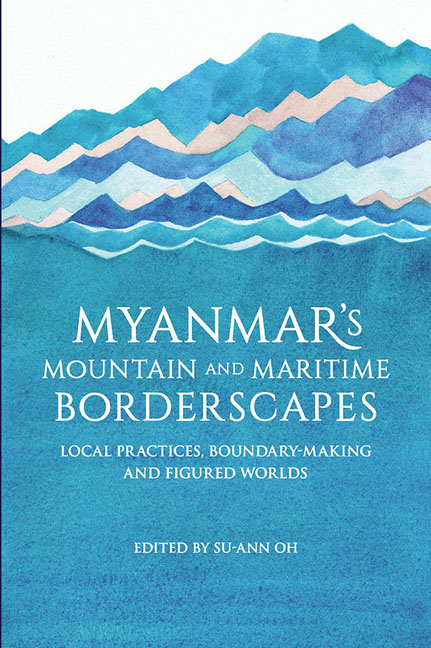Book contents
- Frontmatter
- Contents
- List of Tables
- List of Figures
- Acknowledgements
- Notes on Language, Terminology and Geographical Names
- Contributors
- Abbreviations
- 1 Introduction
- I Overview of Myanmar's Mountain and Maritime Borderscapes
- II Territorial Claims and Imagined Boundaries
- 4 Burman Territories and Borders in the Making of a Myanmar Nation State
- 5 Ritual and the Other in Rakhine Spirit Cults
- 6 Rohingya Territoriality in Myanmar and Bangladesh: Humanitarian Crisis and National Disordering
- III Social Organization and Border Economies
- IV Mobile Practices and Moving Borders
- V Identity Construction and the Politics of Belonging
- VI Institutionalized Identity and Border Practices
- Index
4 - Burman Territories and Borders in the Making of a Myanmar Nation State
from II - Territorial Claims and Imagined Boundaries
Published online by Cambridge University Press: 06 June 2017
- Frontmatter
- Contents
- List of Tables
- List of Figures
- Acknowledgements
- Notes on Language, Terminology and Geographical Names
- Contributors
- Abbreviations
- 1 Introduction
- I Overview of Myanmar's Mountain and Maritime Borderscapes
- II Territorial Claims and Imagined Boundaries
- 4 Burman Territories and Borders in the Making of a Myanmar Nation State
- 5 Ritual and the Other in Rakhine Spirit Cults
- 6 Rohingya Territoriality in Myanmar and Bangladesh: Humanitarian Crisis and National Disordering
- III Social Organization and Border Economies
- IV Mobile Practices and Moving Borders
- V Identity Construction and the Politics of Belonging
- VI Institutionalized Identity and Border Practices
- Index
Summary
How do Burman people perceive and live the borderlands? It has been a few decades since academics started working on Burmanization to explain the national construction of the Union of Myanmar's “geo-body” — the search for a homeomorphism between a territory defined by national borders and a national “identity” (Thongchai Winichakul 2005) — and notably the power struggles between the central state and ethnic areas partly under the control of insurgent armed groups. Walton (2013) even recently discussed the “wages of Burmanness”, an ill-defined national Burman identity resulting from the Burmanization process that, if substituted for the creation of an inclusive national identity, could hinder the development of a democratic Union and the place of ethnic minorities within it.
Nonetheless, only a few studies deal with the perception of a Burman identity by the Burmans themselves, or at least Burman discourses of identity relative to their relationship with other minorities (see Boutry and Ivanoff 2008; Boutry 2015). How do Burmans represent their geographic or imagined territories and define their borders? It seems “easier” to find strong identity markers defining “limited social spaces” (for example, the Moken or Khumi social space) than “extended social spaces”, such as the Burman or Tai ones. Among other reasons, extended social spaces tend to be assimilated to structures of a larger scale such as kingdoms or states, while limited social spaces are deprived of such power structures. The fact that limited social spaces are mainly viewed as in danger of being assimilated by extended ones (Moken assimilated by Burman through Burmanization, for example) explains the greater focus given to studying “disappearing” or “changing” identities on the part of minorities. Yet, nobody seems to find interesting the possible changes occurring within the majority in contact with minorities. Numbers lay down the law. Yet, is it not necessary to try understanding Burman identity when talking of Burmanness or Burmanization? Or are these concepts only political constructions aimed at controlling populations?
From some examples taken along the Myanmar littoral zone, I would like to draw attention to how borders (administrative but also based on identity as we will see) contribute to the different facets of Burman identity.
- Type
- Chapter
- Information
- Myanmar's Mountain and Maritime BorderscapesLocal Practices, Boundary-Making and Figured Worlds, pp. 99 - 120Publisher: ISEAS–Yusof Ishak InstitutePrint publication year: 2016

